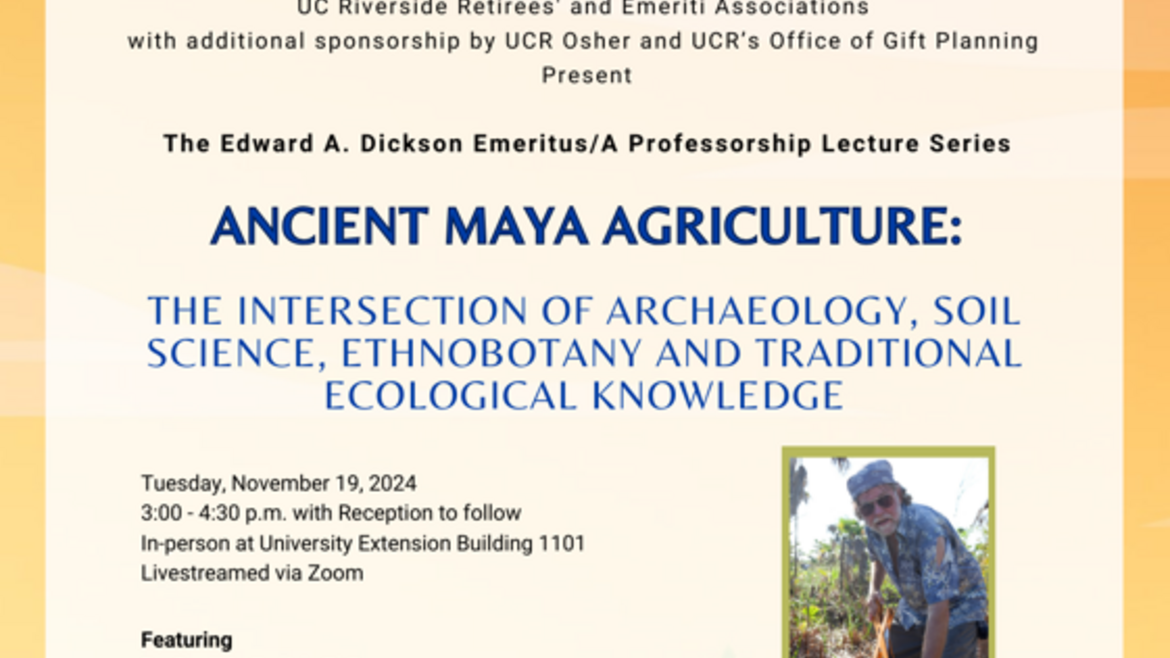
The UCR Retirees’ (UCRRA) and Emeriti (UCREA) Associations invites you to attend the upcoming Edward A. Dickson Emeritus/a Lecture Talk Series. Each year three retired UCR faculty are awarded Edward A. Dickson Professorships to support their research, teaching, or public service activities. In the year following their awards, Dickson Professors give public presentations of their work.
“Ancient Maya Agriculture: The Intersection of Archaeology, Soil Science, Ethnobotany and Traditional Ecological Knowledge”
Presenter: Dickson awardee Scott L. Fedick | Date: Tuesday, November 19, 2024
Time: 3:00 – 4:30 p.m. with a reception to follow | Location: In-person at University Village 1101 and Livestreamed via Zoom
Description
The ancient Maya of southeastern Mexico and Central America were one of the most accomplished civilizations of the New World, well known for their architecture, art, astronomy, and writing system. One enduring mystery of the ancient Maya is how they managed to feed very large populations in a tropical environment with land resources that have long been characterized (by an outsider perspective) as hostile and challenging for agriculture. For decades, it has been suggested that Classic Maya civilization (ca. 250-900 CE) “collapsed” due to environmental degradation resulting from unsustainable agricultural practices, or agricultural collapse due to catastrophic droughts, or some combination of those contributing factors. Scott Fedick’s research during his 25 years at UCR, and continuing since his retirement in 2014, has sought to dispel inaccurate and biased perceptions about the environment of the Maya Lowlands, and to uncover the many ways in which the Maya sustainably managed the forest and agricultural production for thousands of years. Fedick’s most recent research, funded by the Dickson Emeritus Professorship, has taken him back to Belize, where he conducted his dissertation work in the 1980s. Field research undertaken in 2024 was a collaborative effort involving modern Maya forest farmers, a soils crew from Mexico, and long-term archaeological collaborator Dr. Anabel Ford of UCSB. The team made use of the latest LiDAR remote sensing-imagery that has revealed the “bare-earth” terrain and over 2,000 structures within a 20 square kilometer area around the ancient Maya center of El Pilar, on the Belize-Guatemala border. The goal of the research was to model, at a very fine geographic scale, how the ancient Maya organized their pattern of settlement and matched the soil preferences of 31 species of crops now known to have been used by the ancient Maya to the diverse soil resources found in the area. The old notion of ancient Maya agriculture assumed it to be dependent on slash-and-burn cultivation of maize, beans and squash in a uniform and hostile environment. There is a growing appreciation and understanding of Maya ecological knowledge, both ancient and modern, that provided a diverse assortment of indigenous food crops tailored to a “managed mosaic” of land resources and cultivation technologies that successfully sustained large populations.
Refreshments will be provided
Event Registration
This presentation is open to all and thank you to those who have already registered. To join in-person or through livestreaming the event, please register to receive the event details on the Retirement Center webpage at: https://ucriverside.az1.qualtrics.com/jfe/form/SV_7WogHTXjs4odj02.
A Special Thank You to Our Co-Sponsors
UCR Osher
UCR Office of Gift Planning